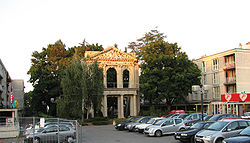
Château de Beauregard, La Celle-Saint-Cloud
Encyclopedia


La Celle-Saint-Cloud
La Celle-Saint-Cloud is a commune in the Yvelines department in the Île-de-France region in north-central France. It is located in the western suburbs of Paris from the center.-Transport:...
south-west suburbs of Paris, five kilometers north of Versailles
Versailles
Versailles , a city renowned for its château, the Palace of Versailles, was the de facto capital of the kingdom of France for over a century, from 1682 to 1789. It is now a wealthy suburb of Paris and remains an important administrative and judicial centre...
.
The name of the domain seems to have its roots in the Middle-Ages. The castle was built on a top of a hill between La Celle-Saint-Cloud and Le Chesnay
Le Chesnay
Le Chesnay is a commune in the Yvelines department in the Île-de-France region in north-central France. It is located in the western suburbs of Paris from the center-History:...
.
In the early XVIIe century, the house was owned by the du Val family, Pierre du Val was the House master of king of France. Then the castle was the property of the Montaigu family, which rented it. During the Revolution and Empire eras, ownership of the castle changed often.
In the mid 19th century, Harriet Howard
Harriet Howard
Harriet Howard, born Elizabeth Ann Haryett was a mistress and financial backer of Louis Napoleon, later Napoleon III of France.-London:...
bought the house and its park. She also bought the Béchevet farm and the Bel-Ébat stud farm, marking a very large 184 ha property. The castle was in a poor condition; she rebuilt in a neo-classical style. She also closed the whole area with a wall. From this castle, she worked for the success of Louis-Napoleon Bonaparte
Louis-Napoléon Bonaparte
Louis Napoleon may refer to:* Louis Bonaparte or Louis Napoléon Bonaparte, , King Louis I of Holland, brother of Napoleon I* Napoléon Louis Bonaparte , King Louis II of Holland, second son of Louis Bonaparte...
(later Napoleon III), of whom she was mistress and financial backer. She died in 1865.
Her son Martin-Constantin Haryett, created Earl of Béchevet by Napoléon III, was a spendthrift, and had to sell the castle in 1870 to the Duchess of Beauffremont.
But a few months later, the Franco-Prussian War
Franco-Prussian War
The Franco-Prussian War or Franco-German War, often referred to in France as the 1870 War was a conflict between the Second French Empire and the Kingdom of Prussia. Prussia was aided by the North German Confederation, of which it was a member, and the South German states of Baden, Württemberg and...
broke out.
The Prussians, installed in La Celle Saint Cloud made Beauregard their headquarters, and built some fortifications.
The Duchess of Beauffremont was ruined, was not able to rehabilite it, and the house was seized.
In 1872, it then became the property of Baron Maurice de Hirsch
Maurice de Hirsch
Maurice de Hirsch was a German-Jewish philanthropist who set up charitable foundations to promote Jewish education and improve the lot of oppressed European Jewry. He was the founder of the Jewish Colonization Association which sponsored large-scale Jewish immigration to Argentina...
, who fully restored it.
Although having a town house in rue de l'Elysée in Paris, he and his family frequently stayed at Beauregard.
At his death in 1896, the castle was bequeathed to Maurice Arnold Deforest, Count de Bendern (Liechtenstein title).
He owned several properties across Europe, and did not come so often to Beauregard, leaving the castle abandoned.
In 1939, there was a project to install an auxiliary hospital, but the poor condition of the castle did not allow it.
It then became a military depot and was bombed in 1940.
During the Occupation, the organisation Todt
Organisation Todt
The Todt Organisation, was a Third Reich civil and military engineering group in Germany named after its founder, Fritz Todt, an engineer and senior Nazi figure...
used it as a base, and then it became an annex of the Fresnes prison
Fresnes Prison
Fresnes Prison is the second largest prison in France, located in the town of Fresnes, Val-de-Marne South of Paris...
and a Russian prison camp.
After the war, Beauregard was in ruins.
Its owner, the Count de Bendern, thought to transform it into a forest reserve open to the public, but he was not able to do it, and eventually gave it to the city of Paris in 1949 for social housing.
In 1956, the castle ruins were cleared. Only the front-core (front door) still stands (but very deteriorated), surrounded by a group of buildings built in the late 1960s in the so called Beauregard neighborhood, 300 meters north of the A13 motorway
A13 autoroute
Autoroute 13, or L'Autoroute de Normandie links Paris to Caen, Calvados.The motorway starts in Paris at the Porte d'Auteuil, a former gate of the Paris walls, and ends at Mondeville's Mondeville 2 exchange junction on Caen's ring road...
.

